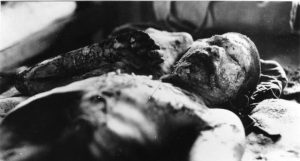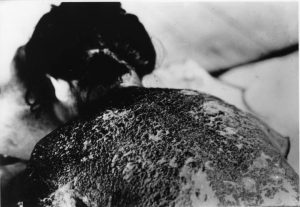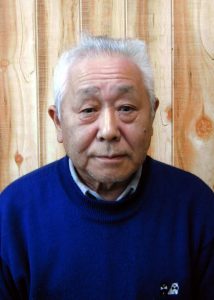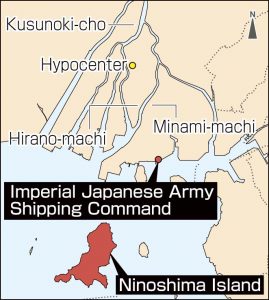Striving to fill voids in Hiroshima, evidence of victims remains 76 years after atomic bombing—Photos of A-bombing destruction, Part 3: Ninoshima Island army quarantine station captured by Masami Onuka
Dec. 7, 2021
Photographer followed cruel order to “make eye contact”
Photos donated to school, where they are exhibited
by Junji Akechi, Staff Writer
“I wondered whether I really had to take such photos. Despite being an order from above, I thought it was so cruel,” said the photographer Masami Onuka (who died in 2011 at age 89). One day after experiencing the atomic bombing himself, he had no choice but to take the distressing photos.
Denied that sense of mission was reason for photographing victims
Mr. Onuka, who was 23 at the time, worked as a member of a photography corps at the Imperial Japanese Army Shipping Command, located in the area of Ujina-machi (now part of Hiroshima’s Minami Ward). On August 6, 1945, he experienced the atomic bombing while attending morning assembly at the command facilities. After receiving an order to return home, he left the area but was unable to locate his mother, Makino Onuka, then 60, who was living in the area of Minami-machi (now part of the city’s Minami Ward). Due to fires, he was also unable to approach his older sister’s home in the area of Hirano-machi (now part of Naka Ward). Finding it impossible to make it back to his boarding house in the neighborhood of Kusunoki-cho (now part of Nishi Ward), he ended up returning to the shipping command. In the afternoon of August 7, the following day, he traveled to Ninoshima Island (now part of Minami Ward), after engaging in the work of helping the wounded.
Starting the day of August 6, numerous wounded had been brought to the army’s quarantine station on the island. According to an order from an army surgeon, Mr. Onuka took numerous photos of victims, including one of a woman with her back completely burned and another of a man with burns over his entire body. When snapping a photo of someone with a horribly burned face, he felt as if the victims’ slightly opened eyes were focused on the camera lens.
In a recorded testimony about his experiences he made in 1992, Mr. Onuka revealed his consternation when ordered to take the photos. “I met their eyes when I snapped the shutter,” he said. “If I had been such a victim in one of my photographs, I would have thought it unacceptable to show me in such misery.” He denied that a sense of mission was the reason behind taking the photos. “I don’t think you can take photos with a camera just because you were told to keep a record for the future.”
Starting August 8, as part of his military work, he continued to take photos at shelters in the city. Those film negatives were burned by military order at the end of the war, but his colleagues and others in the photography corps and military surgeons secretly kept some of the prints. In 1952, after the occupation by Allied forces had ended, Mr. Onuka’s photos were published anonymously in a publication capturing the public’s attention, the Asahi Graph, under the title “First revelation of A-bombing destruction.” The Hiroshima Peace Memorial Museum, located in the city’s Naka Ward, now holds the prints of six photos taken by Mr. Onuka.
Mr. Onuka’s mother was never found. After the war, he operated a photography studio in Kawamoto-machi in Shimane Prefecture, a town neighboring his hometown. Toward the end of his life, he confronted the photos he was forced to take after the atomic bombing, by sharing his experience with students at elementary schools, among other efforts. In an article published in the Chugoku Shimbun in 2005, he was quoted as saying, “People can understand just by looking at the photos. I truly want people to look.” In the same year, he held a photo exhibit.
Mr. Onuka’s son contemplates his father’s footsteps
Mr. Onuka sent a copy of the newspaper article to his third son Kiyoshi Onuka, 59, a resident of Kawasaki City in Kanagawa Prefecture who operates a so-called “cram” school in Tokyo. Kiyoshi said, “Since receiving it, I began to think about my mission as his son.” While carrying a burden from the past, his father continued to take photos at local ceremonies based on his love of photography. Every summer in the monthly newsletter he publishes at his school, Kiyoshi started introducing the work in which his father was engaged for the military by sharing information with his students and their parents on such issues as the atomic bombings, war, and peace.
Mr. Onuka passed away in 2011. His oldest son carried on his father’s work, but he died in 2016, leaving the photography studio to be dismantled in 2019. Kiyoshi inherited his father’s photo prints and related publications and donated them to a private junior-senior high school in the metropolitan Tokyo area that is passionate about peace education. He said he did so because he wanted to “communicate the information to students.” The school spent about three months compiling a catalog of the collection, which was displayed at a school festival in autumn of the same year. The school also is planning to hold exhibits at its partner schools.
Kiyoshi said, “I definitely want to know more about the place where my father did the work.” He is endeavoring to visit Ninoshima Island soon and trace his father’s footsteps. He added, “Even if those photos were not taken of his own accord, my father made an effort to hold on to them. If there’s anything I can do to that end, I want to try being of help.” He continues to contemplate his own role and responsibilities.
(Originally published on December 7, 2021)











